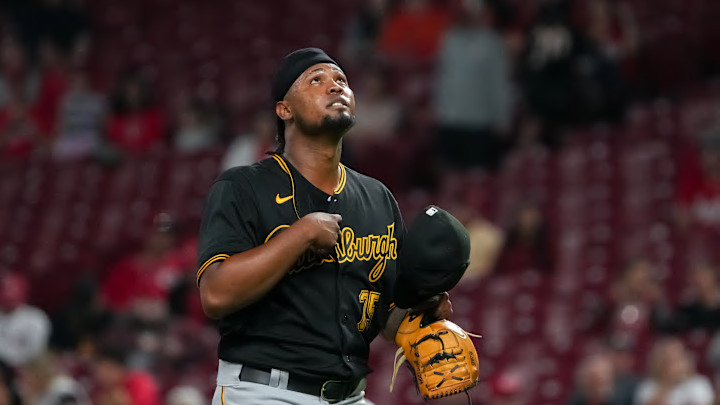The Pittsburgh Pirates have a handful of notable pitching prospects who should start the year at Triple-A this season. But which of these prospects could end up receiving a starting rotation role by the end of the campaign?
The Pittsburgh Pirates have their fair share of top pitching prospects, but they also have a few notable pitchers in the major leagues. By the end of the year, the Bucs could run into a good problem, having a handful of starting pitching-capable prospects for just the five spots in their rotation. Among their top prospects, who ends up in their rotation?
Quinn Priester appears to be a safe bet to take over a rotation spot this season. Priester pieced together a quality season in which he had a 3.29 ERA, 3.59 FIP, and 1.21 WHIP. While the right-hander has never been a big strikeout pitcher, he still had an admirable 23.6% strikeout rate to pair with an 8% walk rate. Preventing the home run has always been Priester's strong suit. He had a 0.6 HR/9 and a ground ball percentage just slightly over 50% at 50.6%. This was the lowest ground ball rate of his career thus far, meaning he has posted a 50% or greater rate every ear of his career.
Even these numbers are bogged down by a few bad starts. In his last and second to last starts of the year (his 17th and 19th start), Priester allowed 11 earned runs (a third of the total ER he allowed all year) in just eight innings (less 10% of his total innings). Aside from these two poor outings, Priester had a 2.40 ERA, 0.44 HR/9, 23.9% strikeout rate, and a 6.9% walk rate. Overall, those represent much better numbers.
Luis Ortiz is also likely to lock down a rotation spot. The Pittsburgh Pirates promoted Ortiz to the major leagues last year after two Triple-A starts. Ortiz also looked quite good, though he did bomb his last start of the year, inflating a small sample size. Ortiz's minor league numbers looked much better, as he owned a 4.56 ERA and 4.40 FIP, but quality 27.1% strikeout rate and 7.5% walk rate.
Ortiz struggled the most with home runs; however, despite his 1.45 HR/9, there is evidence he could decrease that next year. Ortiz had a healthy 47.8% ground ball rate but had a 17.4% HR/FB ratio. xFIP, which tries to adjust for HR/FB rate outliers, pinned Ortiz at 3.75. Despite similar batted ball statistics, the flamethrower also had just a 0.52 HR/9 in 2021 and let up just one barrelled ball in 16 MLB innings. He induced a ton of soft contact, holding opponents to just an 86.1 MPH exit velocity and 85.3 MPH mark until his blow-up game. For reference, Max Fried was in the top 92nd percentile of exit velocity at 86.2 MPH.
Mike Burrows also seems to have a firm grasp on a future rotation spot. The former eighth-rounder has made major strides in developing his change-up over the last two seasons. Last season, Burrows had a 4.01 ERA but a strong 3.29 FIP and 1.21 WHIP in 94.1 innings. Burrows has consistently had a strong strikeout rate and struck out 28.2% of opponents last year. He also had a solid 7.9% walk rate and a .76 HR/9 rate.
Like Priester, Burrows' final start of the year inflated his numbers. Before allowing six earned runs in less than one inning, Burrows entered the day with a 3.46 ERA, 3.11 FIP, and 1.15 WHIP. Despite that one start making up less than 1% of his total innings, the amount of earned runs he allowed was nearly 15% of his ER total.
That leaves Kyle Nicolas and Carmen Mlodzinski in question. I personally am still high on Nicolas. His numbers from 2022 aren't entirely reflective of how good he was. He bombed his third start of the year but was very good aside from that. In his other outings, he had a 3.25 ERA, and 3.77 FIP, along with a 0.51 HR/9, and 26.7% strikeout rate, albeit with a mediocre 12.5% walk rate. Mlodzinski, on the other hand, had a 4.78 ERA, 1.41 WHIP, and a solid 3.77 FIP, but with high month-to-month fluctuations in performance. Nicolas certainly has relief risk, and Mlodzinski has a low-floor/high-ceiling-type profile.
Where guys like Nicolas and Mlodzinski end up could depend on what happens with Johan Oviedo and JT Brubaker. Both Oviedo and Brubaker had a solid chance of landing a rotation spot at the start of next season. Brubaker had a strong mid-April through the All-Star Break, while Oviedo looked great in September. Though Oviedo does have some relief risk and Brubaker can be inconsistent. Brubaker could also end up in the pen, given he has a lower ceiling than any of Nicolas, Oviedo, or Mlodzinski.
It's way too early to make a fully confident projection of what the Pirates' rotation could look like at the end of the 2023 season, but based on the prospects and other players the Bucs have in the majors, you could at least make a solid guess. Mitch Keller and Roansy Contreras have decent job security for a rotation spot, so they're likely not going anywhere. If the Pirates deal Rich Hill at the trade deadline, assuming they're not in contention, the end-of-season rotation could feature Contreras and Keller, alongside Ortiz, Priester, and Burrows. Unless either Mlodzinski or Nicolas starts the season at a torrid pace, this would be the best-projected rotation for the end-of-2023 team.
